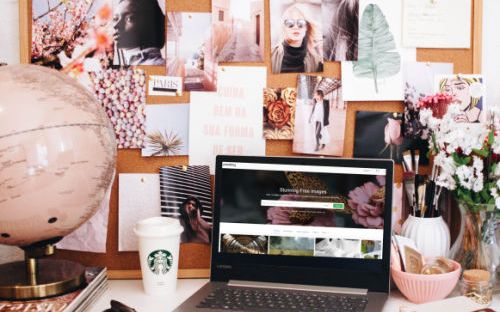Are you stumped on how to find great images for your Business blog? think you’ll have to invest in expensive image-editing software to make great images? Don’t have the budget for stock photos?
Never fear, finding great photos and illustrations to use on your business’ blog or social media accounts has never been easier — thanks to dozens of copyright-free photo sites, like Pixabay and Unsplash, and free image-editing tools like PicMonkey and Canva.
I still buy the occasional image from Shutterstock or another stock photo service — and I still fire up Photoshop every now and again. But most of the time, I depend on these four fab-and-free options, which I’ve quickly grown to love (and stick with) over the years.

Thanks to the plethora of online resources, it’s easy to find (and tweak) great images for your business (or other type of) blog!
Steps to Find and Personalize Blog Photos
When I’m writing a blog post or developing another piece of content, my mind usually goes to what image(s) I plan to use with it. Maybe it’s the junior graphic designer in me (you can read about my design background here), but early on I need to consider both the content and imagery as I set out to create a blog post.
If you’ve struggled with finding great images for your blog or other content piece, just follow these same steps that I take:
- Start the search with a great keyword. The most obvious place to start your search in a copyright-free photo site, like Pixabay, is by using a keyword related to the the main topic of your blog post. If you’re writing about great customer service, you could search for the full phrase great customer service, but I find that the shorter, the better — so customer service would be ideal. (Note: You’re likely to get similar results with both queries, since customer service is used in both.)
- If at first you don’t succeed, search, search again! If using the obvious keywords doesn’t return good/relevant images in the photo site, think outside the proverbial search box and look for related phrases like retail, shopping and buying. Find what you’re looking for? Great!
- Know the photo’s usage rights. Even on a copyright-free photo site, it’s good to read the usage rights on the particular photo you want to use, as well as check the site itself for any guidelines. For example, even though Pixbay’s FAQ page says, in part: “All contents are released under the Pixabay License, which makes them safe to use without asking for permission or giving credit to the artist — even for commercial purposes…”, it also includes wording on what’s not allowed. (Here’s what my other favorite site Unsplash has to say about this topic.)
- Download/save the file to your computer. Pixabay offers a variety of file formats and sizes. Unsplash is more limited. On Pixabay, some images (like on an illustration), are available in SVG (vector) format, which makes them easy to modify in a program like Adobe Illustrator. This allows you to adjust the illustration’s colors, paths (the text and “drawn” elements — straight lines, curves, etc.).
- Modify the image, if you need to. I typically use the image-editor PicMonkey, although I know many people who swear by Canva. Of course, if you own and know how to use Adobe Photoshop and Illustrator, those are editing options, too. With an image editor, you can crop or resize the image, add text to it, adjust its colors, layer an image on top of another image, etc. (Side note: On the image that accompanies this blog post, I did just that by adding my own screenshot of the Pixabay home page to an existing photo — see it on the monitor?) You could also add your blog post name and/or site name or URL to the image, too.
- Be wise and resize. I mentioned cropping earlier, but pay attention to the final size of the image, too. If you’ve been blogging for awhile, you likely know which image size works best for the site’s pages, blog posts, etc. Something else to remember: Using large-sized image files can slow your site down.
Image-Editing Resources
If you’d like to learn more about the topic of editing an image, here are three resources to check out:
- The 11 Best Free Online Photo Editors – This is a nice round-up of available tools, and there are many other review-type articles like this one.
- How to Edit Your Instagram Photos (in PicMonkey) – YouTube is great for getting step-by-step image editing advice about a particular tool.
- 10 Types of Image File Extensions and When to Use Them – A nice overview here!
Now that you’ve read my tips and tricks for how to find a great image for your business blog, I hope you’re inspired to do some search and experimenting. And I hope this goes without saying, but you do know — don’t you? — that you can’t screenshot or download an image from Google search? You could pay a hefty price if the originator of the photo comes calling!
